|
The modern prison is truly a legacy from the past. Born out
of nineteenth-century reform idealism, the fortress-like
penitentiary has weathered shifts in penology and remains a
place where the time-honored goal is custody...
The history of the New York prison system clearly shows the
development of the American penitentiary. At each point
when new approaches have been proposed, the prison itself
has prevailed. Many will argue that incarceration has failed
because it is built on false assumptions. Others maintain that
the problem is a lack of resources and the inadequacies of the
prison bureaucracy. As the Attica Commission's report
shows, the debate about the purpose and effectiveness of
corrections continues. |
The American prison system as we know it began in New York in the early 19th century. The founders of this system were men of high purpose, who conceived of prisons as more than simple warehouses of convicted criminals.
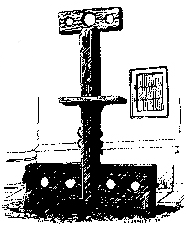
|
|
An all-in-one device -- combination pillory, whipping post and stocks.
|
"Reformation" was their goal, and, as rational men, they developed a concept of imprisonment which was consistent with their beliefs concerning the causes of crime in the simple society of that time. The prisons which these reformers built almost 150 years ago to put their theories into practice survive physically throughout the country and conceptually in maximum security prisons like Attica. [1]
During the colonial period of our history and in the early years of the nation, long-term imprisonment was not a common form of punishment. Execution was the prescribed penalty for a wide range of offenses, while the less serious offenders faced public punishment, such as pillorying, whipping, and even maiming. Places for long confinement of convicted offenders were simply not necessary. Commonly called the age of enlightenment, the 18th century was one of dramatic challenge to traditional thought and customs, including concepts of punishment.
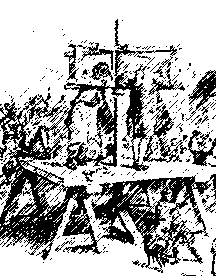
|
|
A pillory for four.
|
By the beginning of the 19th century, imprisonment had replaced public punishment and execution for most crimes except murder and treason.
The early places of imprisonment ranged from large wood frame houses in the cities, from which escapes were frequent, to an abandoned copper mine which Connecticut adopted as its prison in 1790.
The sole objective of those places of confinement was detention. Imprisonment was its own end, and no pretense was made of rehabilitation. Indeed, long-term confinement was itself considered a progressive, humane improvement over the old system of whipping and execution. A repulsion from the gallows rather than any faith in the penitentiary spurred the late eighteenth century construction. Few people had any clear idea what the structure should look like or how they should be administered. . . .[2]
In the early 19th century, however, two very definite concepts of imprisonment were introduced in New York and Pennsylvania, including what the structures should look like and how they should be operated.
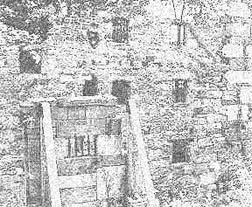
|
|
Old Newgate Prison & Mine, Conn.
|
These concepts resulted in the construction of entire institutions intended not only to house convicted criminals, but also to reform them into temperate, industrious, hard-working citizens, and to return them to their societies as new men. With the emphasis upon reformation of the criminal, sentences would be long enough to allow the prison program to have its desired effect.
It was no accident that in Pennsylvania the institution was called a penitentiary, for the inmates were there to do penance. The Pennsylvania authorities, reflecting their deeply moralistic Quaker faith, were convinced that man became a lawbreaker through evil influences and corrupt companions. The key to reforming him lay in separating him from all potential for such wicked association and providing him with a small room and exercise area, totally isolated from the human companionship which had led him astray. After an appropriate period of total isolation and inactivity, he would be allowed small bits of handicraft work and a Bible in his cell. From the Bible and his work, he would learn the superiority of the life of simple faith, diligent toil, and moderate habits. Blindfolded upon arrival, he was led to his cell where the blindfold was removed and he remained in his cell until he was released, when he was blindfolded again and led out. The solitary cell and its small exercise yard became his entire world. He never saw another inmate, for even the most fleeting of contacts was considered corrupting.
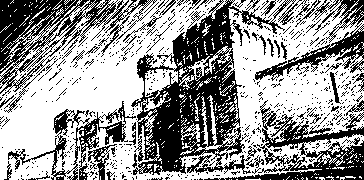
|
Eastern Pennsylvania State Prison: the house of isolation.
For more on ESP history and its educational programs, visit its excellent web site at http://www.easternstate.org or call (215) 236-3300 or write: Eastern State Penitentiary Historic Site, 2124 Fairmount Ave., Philadelphia, PA 19130.
|
Only in the purity of complete isolation could the corruption be overcome and the restoration of faith and honesty be attained. And in complete isolation he was kept.
The New York authorities proceeded on much the same premise as to the cause of crime, but adopted a slightly different solution in the construction of Auburn State Prison in the early 19th century. New Yorkers felt that the isolation of prisoners from arrival to release was too inhuman, it was both unnatural and cruel. Far from reforming men, they felt such absolute solitude bred insanity and despair. In addition, there was the issue, perhaps more pressing, of expense to the state. Inmates restricted to their cells 24 hours a day contributed nothing to the cost of their own confinement. The state had to provide all food, clothing, supplies, and materials to its prisoners.
If the prisoners were to learn the advantages and satisfaction of hard work and thrift, the New York authorities believed, there could be no better way than to be compelled to work together in harmony, if such a system also offered the potential for inmates to grow and harvest their own vegetables, raise and butcher their own meat, make their own clothes, and manufacture other items for use or sale by the state, such a boon to the state's budget could not reasonably be ignored.
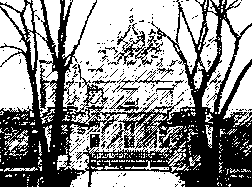
|
|
Auburn state prison.
|
When the doors of Auburn Prison opened in 1819, America had the model and prototype of its maximum-security prison. The New York authorities were as devoted as those in Pennsylvania to the idea of keeping prisoners isolated from each other and from the outside world. Prisoners were not even al1owed to communicate with their families, except through the prison chaplain. New York's departure from the Pennsylvania system was in the commitment to provide a common work and dining area for inmates. Silence among inmates was strictly enforced, however. The New York officials were deeply committed to the view that a steady, predictable, unrelenting routine of hard work, moderate meals, silent evenings, and restful nights in individual cells would produce man who were, indeed, cured of all vices and excesses
Because the inmates left their cells each day to work together, the cells in the Auburn-style (or congregate-style, as it came to be called) prison could be made smaller than those in the Pennsylvania-style penitentiary. The Auburn cells were primarily for sleeping and were not intended to be the prisoner's entire universe. The inmates were awakened early and marched to work for a few hours before breakfast. After lunch they returned to their jobs until time for dinner. After the evening meal, they marched back to their individual cells to relax and sleep before going back to work the next morning. From sunrise to sunset, their days were occupied by a routine as unalterable as the solar timetable it followed. They did not work on Sundays, and the long weekends were spent in the tiny cells that had not been designed as living quarters. On Sundays they were addressed by a prison chaplain who explained to them the wisdom and virtue of their industry and exhorted them to persevere, as all good Americans persevered, in the life of simple faith and hard work.
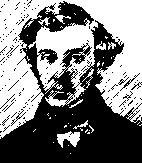
|
|
Alexis de Tocqueville
|
Penologists and reformers from throughout Europe came to America to observe the prison systems of Pennsylvania and New York. Near1y every college freshman in American reads Alexis de Tocqueville's account of "Democracy in America," but few realize that de Tocqueville was in this country, as an official emissary of the French government to study the new American prisons. France, England, Scotland, Prussia, and Germany all dispatched men to study these systems, and most European prisons since 1800 have been patterned after the solitary, Pennsylvania system. Of the two systems, de Tocqueville and his companion de Beaumont wrote, Philadelphia system produces more honest men, and that the New York more obedient citizens. [3]
For economic reasons, most American prisons came to be patterned after Auburn and were as much silent factories and involuntary labor pools as they were bleak prisons. Auburn Prison, in fact, turned a profit in the early years of its existence. [4]
It was an article of faith that these prisons would not only be successful in transforming idle and corrupt men into virtuous laborers, but that they were examples of model communities from which the large society could benefit as well. The Boston Prison Discipline Society reported that the Prison Program, would greatly promote order, seriousness, and purity in large families, male and female boarding schools, and colleges. [5]
A chaplain at the Ohio Penitentiary proclaimed:
|
Never, no never shall we see the triumph of peace, of right, of Christianity, until the daily habits of mankind shall undergo a thorough revolution. Could we all be put on prison fare, for the space of two or three generations, the world would ultimately be the better for it. Indeed, (society should) change places with the prisoners, so far as habits are concerned, taking to itself the regularity, and temperance, and sobriety of a good prison. As it is, taking this world and the next together...the prisoner has the advantage. [6]
|
Discipline was regarded as the key to success of the congregate prison, and one rule soon emerged as the key to discipline. That rule was silence, a silence so profound and so pervasive that it became the most awesome and striking feature of the fortress?like prisons of America. From their tour through Auburn, de Beaumont and de Tocqueville wrote:
|
We felt as if we traversed catacombs; there were a thousand living beings, and yet it was a desert solitude. [7]
|
In order to maintain silence and order in the movement of large numbers of inmates about the prison, Auburn devised the silent, lock-step shuffle.
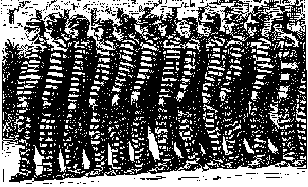
|
|
Inmates in lock-step.
|
Inmates stood in line, each with the right foot slightly behind the left and the right arm outstretched with the hand on the right shoulder of the man in front of him. They moved in a shuffle, sliding the left foot forward, then bringing the right foot to its position just behind the left, then the left again, then the right. This awkward locomotion, coupled with the striped uniforms in New York, was considered therapeutic. Prisoners were not in a state of grace with society, and their condition was made as graceless as possible, lest they forget their corrupt condition. As the prisoners moved, they were not permitted to hold heir heads up, as would befit free men, and their shameful pose with their heads turned to the right and their eyes cast to the floor kept them ever mindful of their low estate and the wickedness that had brought them there. The guard watching such a group shuffling across a prison area could readily spot any unauthorized conversation or activity.
|








